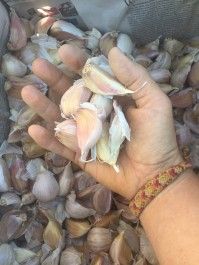 A new Farm Notes is online! This week we're talking about adapting, coping, and thriving in Covid times.
A new Farm Notes is online! This week we're talking about adapting, coping, and thriving in Covid times.
We have rounded the corner in autumn and it feels like we are heading for winter already. Garlic planting is underway--one garlic clove at a time, planted six inches apart, four rows on a bed. It is hands and knees work on beautiful October afternoons. In some ways, the technology (a long stick to poke the holes, a bucket for the garlic cloves) feels ancient. I often think nothing has changed in the world of garlic in thousands of years. The Babylonians and the Egyptians probably used sharpened sticks too.
 After we finish pushing 1000 pounds of garlic into the soil, we will cover the beds with a thick layer of hay mulch. And then we will wait. The garlic will come up through the hay, will pause in its above ground growth for the winter, and will get taller when the days get longer and warmer. In so many ways, it is the perfect crop. It does take nine months to get to harvest, but there is almost nothing to do once it is mulched.
After we finish pushing 1000 pounds of garlic into the soil, we will cover the beds with a thick layer of hay mulch. And then we will wait. The garlic will come up through the hay, will pause in its above ground growth for the winter, and will get taller when the days get longer and warmer. In so many ways, it is the perfect crop. It does take nine months to get to harvest, but there is almost nothing to do once it is mulched.
Planting garlic is the ultimate act of hope. It is the first crop that we plant for 2021. We plant with confidence and faith that we will be here next year to pull it up in July. It's a big investment--garlic seed costs the same as the garlic that we sell--but it is one of the most satisfying foods that we produce. We harvest in July and we do our best to keep it in good shape until we run out in the middle of winter. And it does taste so much better than garlic that comes from commercial sources (mostly from China).
And how in the world would we ever be able to eat all these greens if we didn't have garlic?




